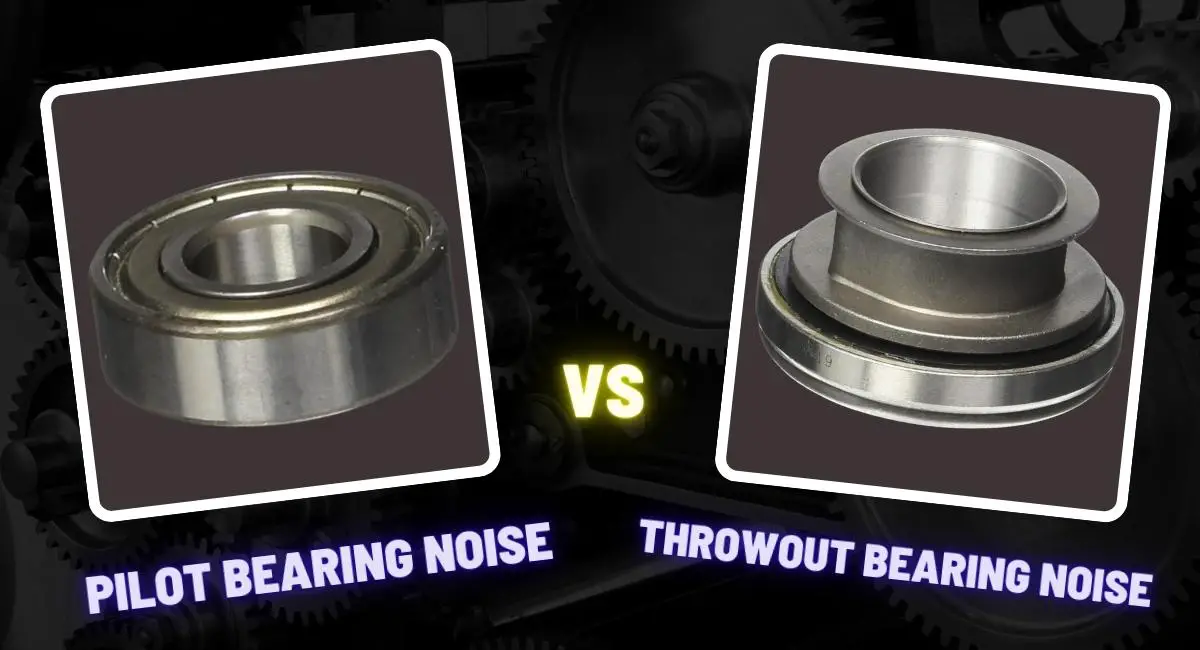The clutch system of a vehicle relies on several components working together seamlessly to ensure smooth gear transitions and optimal performance. Among these components, the pilot bearing and throwout bearing are critical in facilitating clutch engagement and disengagement.
so,the pilot bearing, or the input shaft bearing, is positioned at the flywheel’s center. On the other hand, the throwout bearing also called the release bearing, is located on the transmission’s input shaft adjacent to the clutch pressure plate. However, as mechanical parts, these bearings can deteriorate over time, resulting in troublesome noises and potential damage.
This comprehensive article will explore pilot bearing vs. throwout bearing noise, discussing the importance of these bearings, their respective functions, and the specific noises associated with their malfunction.
Pilot Bearing vs. Throwout Bearing Noise
Understanding the distinctions between a pilot bearing and a throwout bearing is crucial to comprehend the nature of bearing noise. These components serve different purposes with a position in various areas within the clutch system.

Pilot Bearing
The pilot bearing, also known as the input shaft bearing, is situated at the center of the flywheel. It plays a critical role in maintaining the alignment between the engine and the transmission when the clutch is engaged. By reducing friction and providing stability to the transmission’s input shaft, the pilot bearing helps ensure smooth power transfer and prevents unnecessary wear.
Throwout Bearing
Positioned on the transmission’s input shaft, adjacent to the clutch pressure plate, the throwout bearing, or release bearing, is responsible for engaging and disengaging the clutch. It facilitates seamless gear changes by applying pressure to the pressure plate when the clutch pedal is pressed or released. The throwout bearing allows for smooth disengagement of the clutch, enabling the driver to shift gears effortlessly.
Pilot Bearing Noise
The pilot bearing minimizes friction and stabilizes the transmission’s input shaft. When it becomes damaged or worn, various noises can emerge.
Signs of a Bad Pilot Bearing
You may wonder, what does a bad pilot bearing sound like? A bad pilot bearing, or input shaft bearing, within a vehicle’s clutch system, can exhibit several signs indicating potential issues. Recognizing these signs is crucial for diagnosing and addressing pilot-bearing problems. Here are some common signs of a bad pilot bearing:
- Unusual Noises: One of the most prominent indicators of a failing pilot bearing is the presence of unusual noises. These noises may include grinding, rumbling, or growling that persists while the engine runs. They are often more pronounced when the clutch pedal is pressed or released.
- Noise during Clutch Pedal Operation: A bad pilot bearing can produce noise during clutch pedal operation. This noise may manifest as a squeaking or metallic grinding when the clutch pedal is engaged or disengaged. It indicates possible wear or damage to the bearing.
- Noise Disappearing with a Fully Pressed Clutch Pedal: In some cases, the noise associated with a faulty pilot bearing may vanish when you fully press the clutch pedal. It occurs because the bearing is not under load when the clutch is fully disengaged, temporarily alleviating the noise.
- Difficulty Shifting Gears: A failing pilot bearing can cause problem in shifting gears smoothly. You may experience resistance or rough gear transitions when operating the clutch. This problem can be a result of the pilot bearing’s inability to maintain proper alignment between the engine and the transmission.
- Clutch Vibrations: A worn or damaged pilot bearing can increase vibrations in the clutch pedal. You may feel these vibrations when engaging or disengaging the clutch, indicating an issue with the bearing’s functionality.
- Excessive Clutch Pedal Play: A bad pilot bearing can contribute to excessive play or looseness in the clutch pedal. You may notice increased free travel or a lack of responsiveness when pressing the pedal, suggesting a problem with the pilot bearing.
Throwout Bearing Noise When Clutch is Disengaged
When the clutch is disengaged, the throwout bearing plays a crucial role in the clutch system. It applies pressure to the clutch pressure plate, causing it to move away from the clutch disc and disengage the clutch. However, the clutch throwout bearing noise can develop issues over time, resulting in distinctive noises when the clutch is disengaged.
Signs of a Bad Throwout Bearing
Whining or Squealing Noise: When the clutch is disengaged, a whining or squealing sound is a throwout-bearing failure. This noise often indicates inadequate lubrication or excessive wear on the bearing. Excessive wear on the bearing can also contribute to the noise, as the worn surfaces rub against each other during clutch disengagement.
Continuous Noise with Clutch Pedal Pressed: Another noise you may hear when the clutch is disengaged is continuous. It can range from a faint hum to a loud grinding sound. It suggests the throwout bearing has worn out and is no longer functioning optimally. The continuous noise results from the bearing not being able to disengage the clutch, causing it to make contact with other components.
Noise Changing with Clutch Pedal Movement: Sometimes, the noise a failing throwout bearing produces may change with clutch pedal movement. It means the noise may increase or decrease in volume or pitch as you operate the clutch pedal. This change in noise can indicate a potential problem with the throwout bearing, such as worn-out surfaces or misalignment. It is essential to address these issues promptly to prevent further damage to the clutch system.
It’s important to address the throwout bearing noise that occurs when the clutch is disengaged, as it can lead to more significant clutch problems if left unattended. If you notice any unusual noises when the clutch is disengaged, it is advisable to have the throwout bearing inspected and replaced if necessary.
Causes of Throwout Bearing Noise
Throwout bearing noise within a vehicle’s clutch system can stem from various underlying causes. Understanding these causes is essential for diagnosing and addressing throwout bearing issues effectively. Here are some common factors that can contribute to throwout bearing noise:
Lack of Lubrication
Inadequate lubrication is a common cause of throwout bearing noise. The bearing relies on proper lubrication to reduce friction and ensure smooth operation. Insufficient or degraded lubricant can lead to increased friction between the bearing and its surrounding components, resulting in noise generation.
Excessive Wear
Over time, the throwout bearing can experience wear due to the constant engagement and disengagement of the clutch. Factors such as driving habits, clutch adjustment, and maintenance practices can contribute to accelerated wear. As the bearing wears down, it may produce noise, indicating the need for attention.
Misalignment
Improper alignment between the throwout bearing and other clutch components can lead to noise issues. Misalignment may occur due to clutch system adjustments, worn or damaged parts, or assembly errors during installation. When the throwout bearing is not properly aligned, it can create friction and noise during clutch operation.
Damaged Bearing Components
Damage to the throwout bearing components, such as worn-out bearing races or balls, can result in noise generation. This damage may occur due to excessive wear, contamination, or the presence of foreign objects in the bearing assembly. Damaged components can create irregularities and vibrations, leading to noise when the clutch is engaged or disengaged.
Incorrect Installation
Incorrect installation of the throwout bearing can cause noise issues. If the bearing is not properly seated or secured within the clutch assembly, it may result in misalignment, excessive play, or restricted movement. These installation errors can contribute to noise during clutch operation.
High-Speed Gradients (Racing Applications)
In racing applications or high-performance vehicles, throwout bearings may experience extreme speed gradients due to aggressive driving or high RPMs. These intense conditions can put additional stress on the bearing, leading to accelerated wear and potential noise generation.
It is important to identify the specific cause of throwout bearing noise to address the underlying issue effectively. If you notice unusual noises coming from the throwout bearing, it is recommended to have the clutch system inspected by a qualified mechanic. They can diagnose the cause of the noise and recommend appropriate repairs or replacements to restore the clutch system’s proper functionality and reduce noise.
Steps for Diagnosing Pilot Bearing and Throwout Bearing Noise
- Visual Inspection: Inspect the clutch system components for visible signs of damage, wear, or misalignment.
- Listening for Noise: Carefully listen for the specific noises described earlier while operating the clutch pedal and the vehicle.
- Seek Professional Assistance: If you need clarification on the noise source or lack the necessary expertise, it’s advisable to consult a qualified mechanic.
Solutions for Addressing Bearing Noise Issues
When dealing with bearing noise issues in the clutch system, it is important to address them promptly to prevent further damage and ensure smooth operation. Here are some solutions for addressing bearing noise issues:
Repair or Replacement: If a pilot bearing or throwout bearing is found to be faulty, it should be repaired or replaced promptly to prevent further damage to the clutch system.
Check and Adjust Clutch Components: Proper adjustment of the clutch components, including the pedal free play and clutch cable or hydraulic system, can help mitigate bearing noise.
Lubrication and Maintenance: Regularly lubricating the throwout bearing, as per manufacturer recommendations, and maintaining the clutch system can prolong the life of the bearings and reduce noise.
Clutch Adjustment: Incorrect clutch adjustment can contribute to bearing noise issues. Ensure that the clutch system components, including the clutch pedal, cable, or hydraulic system, are properly adjusted according to the manufacturer’s specifications. This can help alleviate bearing noise and ensure proper clutch engagement and disengagement.
Alignment Check: Misalignment between the bearings and other clutch components can cause noise. It is important to verify proper alignment during installation or repair. Misaligned bearings should be adjusted or realigned to ensure smooth operation and minimize noise.
Important Read: Analyzing Light Electric Brakes Vs Heavy Electric Brakes
Conclusion
Pilot and throwout bearings are critical components of a vehicle’s clutch system. Recognizing signs and sounds of bearing problems is essential for optimal clutch performance. Addressing these issues promptly and implementing solutions can ensure a smoother and quieter driving experience while preserving your clutch system. Regular inspections, periodic maintenance, and seeking professional assistance are key to preventing bearing noise and maintaining overall vehicle performance.
